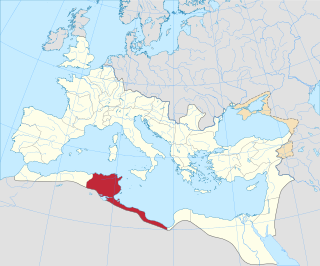
Dhorbania, also known as Henchir Oued Nebhana, [1] is a village and locality in Tunisia. It's also the site of Ancient city and former bishopric Bahanna, now a Latin Catholic titular see.

Dhorbania, also known as Henchir Oued Nebhana, [1] is a village and locality in Tunisia. It's also the site of Ancient city and former bishopric Bahanna, now a Latin Catholic titular see.
Dhorbania is in the Kairouan Governorate of Tunisia, North Africa. It is located at latitude 36.19392n and Longitude 10.02064e, in the hinterland of the Gulf of Hammamet, and south of Tunis. It is on the Oued Nebhana Stream, [2] [3] and it has a post code of 1160 in the Tunisian postal service. [4]
Ruins of the city include a Christian basilica, baptistry, an Olive press [5] and a bridge over the stream. [6]
The Arab general Uqba ibn Nafi lead Arab forces into the region in 670AD.
Bahanna was important enough in the late Roman province of Byzacena to become one of the suffragan bishoprics of its capital Hadrumetum (modern Sousse)'s Metropolitan Archbishopric, but like most faded, presumably under Islam. [7]
The diocese was nominally restored in 1933 as Latin Catholic titular bishopric (Curiate Italian Baanna).
It had had the following incumbents, all of the fitting episcopal (lowest) rank :

Zarzis also known as Jarjis is a coastal commune (municipality) in southeastern Tunisia, former bishopric and Latin Catholic titular see under its ancient name Gergis.
Palaeopolis (in Asia) was a city in ancient Lydia that was included in the late Roman province of Asia Prima. Its bishopric was thus a suffragan of Ephesus, the metropolitan see of that province.
Rucuma is a former city and bishopric in Roman North Africa, which remains a Latin Catholic titular see.
Albulae is an ancient city and former bishopric in Roman Africa. It remains a titular see of the Roman Catholic Church. It is identified with the modern town of Ain Temouchent, in present Algeria, near the Moroccan border.
Tisili is a former city and diocese of in Roman Africa; it is now a Catholic titular see in modern Tunisia, with its precise location not being defined.
Aquae Albae in Byzacena was an Ancient city and bishopric in Roman Africa and remains a Latin Catholic titular see.

Vazari-Didda or Vazari Didda) was an Ancient city and bishopric in Roman Africa, which remains a Latin Catholic titular see.
Ausuaga is an ancient city and former bishopric in Roman Africa. It is currently a Latin Catholic titular see. Its present location is somewhere in modern Tunisia.

Castra Nova was a Roman-era city and diocese in Mauretania, Africa Proconsulare. The town is identified with the stone ruins at Mohammadia, Mascara in modern Algeria. It is now a Roman Catholic titular see.
Rougga is a town in southern Tunisia located in Sfax Governorate, on the Oued er Rougga wadi. Rougga is the Berber name of the town, which is known as Raqqa in Arabic. The town is located on the site of the Ancient Roman African city and former bishopric Bararus, which remains a Latin Catholic titular see.

Tamalluma is a former Roman city which remains a Latin Catholic titular bishopric
Cellae in Proconsulari was an ancient city and bishopric in Roman Africa, which remains a Latin titular see.

Gummi in Byzacena was a city and bishopric in Roman Africa, which remains a Latin Catholic titular see.
Bordj-Bou-Djadi is an archaeological site and former Catholic diocese located on the outskirts of Tunis, Tunisia. The area is situated near Ucres, at 36.901123n, 9.97083e. It is now a Latin Catholic titular see.
Limnae (in Pisidia) was a city and bishopric in the Roman province of Pisidia (Asia Minor), which is now a Latin Catholic titular see.
Erythrum was a city and bishopric in Roman Africa, which remains a Catholic titular see.
Cabarsussi was an ancient civitas (municipality) and bishopric in the Roman province of Byzacena, that is tentatively identifiable with ruins at Drâa-Bellouan in modern Tunisia. The current bishop is Terence Robert Curtin, auxiliary bishop of Melbourne.
Tunnuna was an ancient city and diocese in Roman Africa. It is now a Latin Catholic titular see.

Gratiana was an ancient city and bishopric in Roman Africa, which remains a latin catholic titular see.

Horta was a city and bishopric in Roman Africa, which only remains as Latin Catholic titular see.